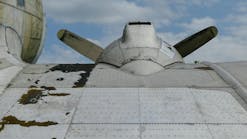AI Is on the Aviation Ascent Path: Practical Uses for AI in Aviation Maintenance
Since November 20, 2022 when ChatGPT was first released, it seems as if all anyone can talk about is Artificial Intelligence (AI). Generative AI is certainly impressive and the known applications for the technology are just scratching surface. The general public now has a chance to play interactively with AI to exploit the opportunities it brings, and the applications for efficiency and productivity gains in industry seem almost limitless.
But how can we apply AI in an industry such as aviation, an industry that is notoriously cautious, safety, conscious, and requires visibility and traceability (for good reason) - all of which go against the current perception of AI as a tool for change? Well, AI as an umbrella term, and indeed for aviation, constitutes way more than just ChatGPT style Generative AI (the AI that makes new things) and Large Language Models (LLM) (the AI that is trained on huge sets of written data using Natural Language Processing (NLP) to be able to predict and generate text).
Practical future use of AI in aviation involves two different deployments of AI: either using AI only to surface options or information, or explainable AI. Let me explain.
Information Surfacing for Decision Support
A foundational principle in aviation is the idea of the trained individual that takes responsibility for decisions, under appropriate authority and licensing. One way to employ AI in aviation but still uphold this principle is to use AI to efficiently surface information or identify options to a human in a form of decision support. This still require the human to make the ultimate decision under their authority. In this way, AI can speed up research or pare down non-useful options, thereby helping the human being to come to a decision more quickly without taking them out of the loop.
Explainable AI Must Be Responsible AI
The next option for the use of AI in Aviation lies in the concept of explainable AI. Many machine learning algorithms are often regarded as magical “black boxes” where information goes in, magic happens, and actions come out the other side. But in a scenario where decisions and actions need to be explainable to a regulator and need to comply with OEM and regulatory requirements, saying “the AI decided because of magic” isn’t an acceptable reasoning.
Here’s where Explainable AI is starting to gain more and more traction.
Explainable AI is a set of tools or frameworks that allow us to understand predictions made by an AI model. As someone deploying a model, these tools can help to improve the model accuracy and performance. For someone trying to understand the model’s outcome, they help to understand why the model arrived at that outcome.
In the future, being able to explain how a model arrived at a conclusion or outcome is going to be key to widespread adoption in aviation.
But now, in the present, there are already four practical applications of AI in aviation maintenance:
1. Maintenance Scheduling & Supply Chain Optimisation
2. Error Detection & Reclassification
3. Automated Failure, Troubleshooting, and Repair Identification
4. Predictive Maintenance & Anomaly Detection
I think we might be able to plan that a little more efficiently, don’t you?
Maintenance Scheduling & Supply Chain Optimisation
A major application of AI that isn’t as prominent in the zeitgeist but has many practical applications is optimisation. There are many different types of AI models that can perform optimisations but some of the most common involve iterative approaches, running hundreds of thousands of scenarios in an instant and regressing the results to an optimal outcome. There are a multitude of applications for optimisation in aviation but since we’re talking aviation maintenance, maintenance scheduling optimisation is the obvious standout.
Giving up maintenance yield costs real money in terms of having to perform more maintenance over time but also having the aircraft out of service for longer means lost revenue. An optimisation engine that can schedule maintenance at the best possible time at the best possible location has the potential to greatly reduce maintenance costs and improve maintenance yield fleet wide.
At the same time, within a given maintenance visit, optimising the order in which tasks are performed and how personnel are assigned to tasks, can result in a maintenance visit being performed much more efficiently – reducing costs, and improve turnaround time (TAT), getting the aircraft back in the air sooner – thereby generating more revenue.
If you take optimisation and apply it to the maintenance supply chain, you can further reduce material delays by ensuring that the right parts are always where you need them, when you need them to get your aircraft back in the air as quickly as possible.
Are you sure that’s what you meant? Error Detection & Reclassification
Another use of AI is to help identify errors made in entering data, or to reclassify data after the fact to ensure accuracy of data and improve the overall quality of the dataset. A common problem across the airline industry is the misclassification of the failed ATA system when raising a fault. Sometimes this is the result of human error, but often the fault gets raised based on the symptoms and then gets deferred. Then, when the fault is eventually resolved, it is learned that the original fault classification was not the actual culprit system – that there was another root cause. These misclassifications can impact the data quality in the system.
Airlines might task staff in their technical records team or reliability engineers to go through records and identify errors and perform reclassifications. This can be a costly, time-consuming, and painstaking process. IFS Customer Southwest Airlines has rolled out a solution to use AI to identify misclassified faults and improve the overall quality of their data. This is an excellent application of LLMs that learn to identify patterns in the text entered by the technicians to classify faults more accurately. Using AI to identify potential errors and surface those potential errors to a person, like the reliability engineer, but allowing the reliability engineer final say, helps to make the whole process vastly more efficient while maintaining authorised human oversight.
How about you try this? Automated Failure, Troubleshooting, and Repair Identification
When a fault is raised, a technician is often required to spend a considerable amount of time, pouring over the fault-isolation manual, and researching the correct source of a fault, what troubleshooting steps to take and what repairs to apply.
The logical extension of fault classification is to take the same kind of LLM model and rather than have it recommend reclassifications, would be to have it, when a fault is identified, suggest potential sources of the failure, and recommend troubleshooting activities or even make repair suggestions. Suggestions would be based on previous success rates with the aim not to be telling the technician what to do but to surface information to the technician to speed them up by providing them with options, by paring down the noise, to help them use their time more efficiently.
By providing first time fix rate percentages to the technician, they may choose options that save time by resolving the issue more expeditiously, meaning the aircraft may be able to get back in the air sooner, or even prevent recurrences down the road and fewer delays mean more profits for airlines. Avoiding or reducing delays has real value to airlines. According to Airlines for America, in 2023, delays have a direct cost of $101.18 for every minute a flight is delayed.
Maybe it’s time for a removal? Predictive Maintenance & Anomaly Detection
The concept of predictive maintenance is nothing new. In fact, the evolution of modern predictive maintenance warrants its own article. However, what is new is the application of newer types of AI, namely Anomaly Detection and Pattern Recognition. Predictive maintenance uses time-series data – data gathered over long periods of time recoded at fixed known points along the way, i.e., discrete data points in time.
Early models looked backwards only. Live feeds of sensor data changed that with the advent of IoT, allowing current data to also be considered. But that amount of data is huge and was difficult to interpret, requiring highly trained data scientists. Then Machine Learning (ML) came into the picture. The advent of ML meant that the highly trained people were now focussed on creating the current learning model for the AI, rather than developing the algorithm themselves.
Now, however, Unsupervised learning models are lowering the barrier to entry for the use of AI in predictive maintenance applications. Although to a lay person, the concept of “unsupervised” learning models for AI might seem scary, it actually means is that you can plug the AI into a set of data and it can figure out its own algorithm.
Not only does this reduce the time and cost of implementing a solution, but it also has the power to strip out bias from the process, particularly when dealing with large amounts of unlabelled data like, oh, maybe the thousands upon thousands of sensor data points generated from a modern aircraft or jet engine—management consulting firm Oliver Wyman expects the newest generation aircraft by 2026 will be generating between five and eight terabytes of data per flight.
When we’re talking about Anomaly Detection, it means that you are able to plug the AI into the sensor data and it first figures out what “normal” looks like, and then it warns you whenever a deviation from “normal” actually occurs. This is your early warning system. Couple that with the concept of Pattern Recognition, meaning that the AI can learn to detect patterns in the sensor data that indicate certain events are about to occur and you get an early warning system that can tell you exactly what is about to happen with extremely accurate results.
The AI Future is Now
AI undoubtedly needs to be deployed with great care – nowhere more so than in the realm of aviation. By using AI to streamline the human’s job, to provide decision support to the human, to pare down the noise of information but all the while keeping the human in the loop and still requiring them to be the ultimate decision maker, cutting edge companies have the ability to make huge strides in terms of efficiency and accuracy. These improvements can represent real value to airlines & air operators and ultimately, their customers. AI is here. It’s here to stay, and early adopters have the chance to get an edge unlike any other.






